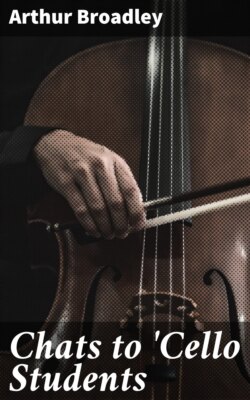Читать книгу Chats to 'Cello Students - Arthur Broadley - Страница 10
На сайте Литреса книга снята с продажи.
How to Hold the Bow.
ОглавлениеTable of Contents
Fig. 2.
Fig. 3.
There can be no departure from the acknowledged way of holding the bow if the best results are to be obtained, that is to say, that the rules must be strictly observed as far as the individual shape of the hand will allow. It will be observed that the nut of the 'cello bow is scooped out on the inner side, which forms two projections, one of these, the lower one, is surrounded with metal through which the hair of the bow passes, the upper projection fits against the stick. The extreme tip of the thumb should be placed on this upper projection (Fig. 2) so that it is also partly on the stick, the thumb being assisted in holding the bow by the second and third fingers. The second or middle finger is so placed that the tip touches or overlaps the hair close to the lower projection; the third finger falls naturally into its place next to the second finger, and has its tip touching the metal, or silver ferrule on the lower projection (Fig. 3). These two fingers and thumb are all that are required to hold the bow, the fourth finger serves to balance the bow and should be placed lightly on the stick, its chief work being to prevent the bow dropping too much when playing at the heel, and to ease the pressure on the strings in very light passages. Last but not least comes the first finger; this is the member which is responsible for quality and quantity of tone, it should have a slight bend round the stick, and so that the other fingers do not interfere, it should be placed slightly apart, this also helps to bring out a louder tone if required. The first finger like the fourth is not compelled to remain stationary, thus in long semiquaver sautillé passages, where the extended position of the first finger would interfere with the natural spring of the bow, it should be made to relax its pressure and take a position nearer the second finger; again in long sustained heavy notes the first finger may be extended slightly, so that more pressure may be put on the bow. These last remarks are most important, as the whole success of the student's bowing rests on the correct use of the first finger, and the proper position of the thumb. I cannot quit this subject without mentioning the importance of having the muscles, especially the tendons on the back of the hand, perfectly easy when the bow is in position.
To allow this, the knuckles must not protrude in the least, the fingers also help by being allowed to bend easily at their middle joints, the upper phalanges having an almost horizontal position over the bow (Fig. 2). The wrist is more rounded when playing near the heel than at the tip, and also when playing on the lower strings. Without the aid of an Edison Cinematograph, it would be impossible to demonstrate pictorially the action of the wrist, fore-arm, and upper arm during the transit of the bow from heel to tip, and on all the four strings, but if the preceding instructions are carried out the bow will at least be held properly. Although my remarks may seem rather drawn out on this subject, from my own personal experience I may say that could I have had this knowledge imparted to me a couple of years earlier than was the case, much unlearning and relearning at more than double the expense would have been saved. To the student who is in possession of the Seb. Lee instruction book, I would remark that the position of the thumb as shown in the plate superscribed "Position de l'archet" (Fig. 2) is decidedly misleading. It is impossible to have the thick fleshy part of the thumb near the first joint, grasping the nut as there shown, without having the fingers stiffly extended, and the knuckles protruding; a position which I wish the student to guard against.
